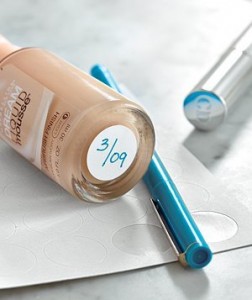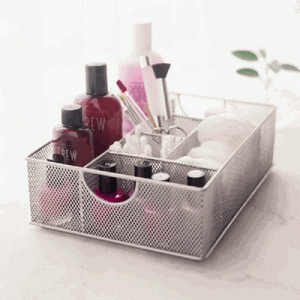Last week our blog focused on the medicine cabinet. This week, we’ll discuss another area of the bathroom that can easily become disorganized and out-of control, your beauty product drawer. Just like your medicines, proper storage of your beauty products can ensure safety and longevity. First, we’ll start out with a few basic tips.

1) Keep makeup in a dark, cool, and dry place in order to minimize degradation.
2) Hold to makeup expiration guidelines and you’ll decrease your risk of infection and/or undesirable effects (sunburns from use of expired sunscreen). An easy way to remember when products will expire is to label the product with date it will go bad (see photo). Use this list by Good Housekeeping to determine opened product expiration time-frames.
3) Don’t forget about applicator cleanliness. Just as makeup can harbor dangerous bacteria, so too can your brushes and sponges. Make sure to set aside time every couple of weeks to clean these items with appropriate solutions.
Once you are ready to organize your makeup, we recommend the following strategy. First, remove all products from your storage area or container. Review the contents and determine which to keep (currently in use), trash (expired/empty) or donate (unopened/new products). It’s common for women to stockpile beauty products, particularly freebies from hotels or gift-with-purchases; the problem is that most go permanently unused. Use this organizing process as a chance to clear these types of items out of your storage space.
The next step is to group like items together. Brushes with brushes, face products with face products, and so on. If you have different types of beauty products for different seasons, group them together and consider storing out-of-season items in a less accessible spot. For instance, you may not need your bronzer taking up prime real estate during the summer months when you have a natural glow. 
Once you have categorized your collection, determine what type of containing system will work best for you. There is no perfect solution, but popular options include small drawer systems, trays, stacking bins, apothecary jars, chests, and bags for women who frequently travel. Ideally, the storage system should have multiple compartments to house your various categories. After organizing everything in it’s new homes, consider labeling the compartments for easy-returning of items.
This process should ideally be conducted once every 2-3 months to maintain continued organization.
Good Luck!
TWOW












